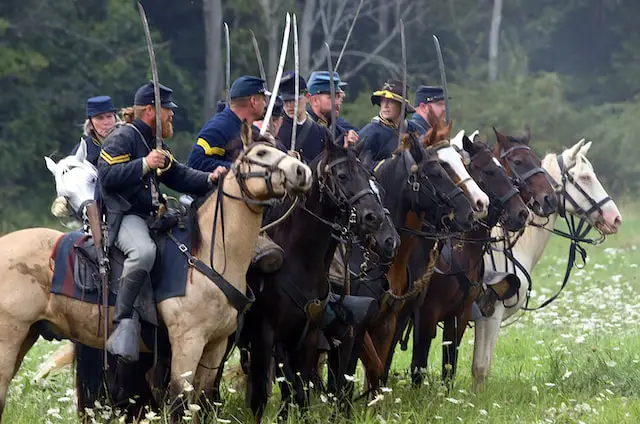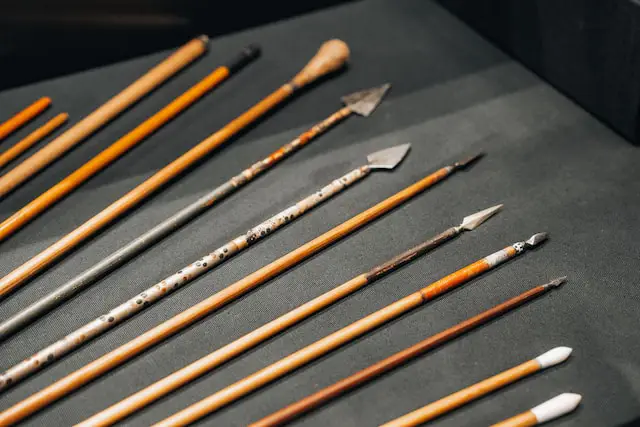Slashing spears have been crucial throughout human history because of their adaptability and powerful force. Types of spears that slash have substantially changed over time, according to various combat situations and cultural circumstances. We’ll into the fascinating world of slicing spears and their enduring significance in this investigation.
Ancient Slashing Spears
We explore the powerful weapons of earlier times in the world of Ancient Slashing Spears. These spears were crucial in ancient battlefields, from the massive spatha of Rome to the potent doru of Greece. Learn about the warriors who mastered their use of slicing weapons and their cutting abilities.
A Roman Marvel
The spatha, a rare type of slashing spear, emerged during ancient Rome. It was characterized by a long and straight blade with a sharp edge, making it a powerful weapon for slashing attacks. Roman infantry expertly wielded the spatha, utilizing its slashing techniques to great effort in battles.
Warrior’s Choice
The doru became a well-known cutting spear in ancient Greece. Its blade’s leaf-like design allowed for strong slashing techniques, making it a lethal tool for both combat and hunting. To disperse the opposition and take control of the battlefield, Greek hoplites used the doru’s cutting prowess.
Elegance and Lethality
To demonstrate the grace and effectiveness of their martial arts, Japan invented the yari, a slicing spear with a distinctively curved blade. Samurai soldiers improved the use of the yari by fusing graceful precision cutting and thrusting tactics. The Japanese military and martial arts developed around this deadly weapon.
Medieval Spears
The billhook became a useful slashing spear. It served several functions because of its hooked blade and pointed tip. It may dismount a rival knight or pierce impenetrable armor.
The goal of the poleaxe was to pierce armor and cause lethal wounds. While the hooked backside allowed for gripping and disarming opponents, the long shaft provided leverage for devastating slicing strikes. When fighting fully armored opponents, the poleaxe was a necessity.
Spears for Hunting

The boar spear became well-liked in Europe as a slicing tool for hunting difficult games. Hunters could deliver precision cutting strikes with its long, frequently serrated blades while keeping a safe distance from the ferocious boar tusks and other wild animals’ spears of prey.
Slashing spears have a long history in Africa, with the Zulu slashing spear standing out as a particularly potent weapon. The law’s long, broad blade gave Zulu warriors the ability to make quick but potent cutting attacks.
Renaissance Slashing
Its long, narrow blade, which had several sharp edges, allowing for a variety of cutting motions. The combination of partisan’s cutting and thrusting capabilities made it a preferred weapon in the arsenal of Renaissance fighters.
Flexibility Ranseur
The ranseur, a multifunctional slashing spear, was also created by sophisticated Europeans. The ranseur’s three-bladed head provided a variety of slashing choices. It delivered quick, deadly cuts while deftly deflecting opponent attacks.
Modern Spears
The bladed thrusting spear has become well-known in modern times for its cutting and thrusting capabilities. This weapon gives the best of both worlds by combining the characteristics of a traditional spear with a sharpened blade. It works well in fighting or for self-defense due to its slashing skills.
Grace Meets Precision
The naginata, a contemporary cutting spear used in martial arts, is a prime example of Japan’s ongoing interest in slashing methods. The naginata is an essential tool in classical Japanese martial arts because of its beautiful movements and lethal slices.
Southern Africa’s Assegai
The assegai, a modern form of a slashing spear that is still utilized today, holds great significance in their traditions. Its cutting abilities enable effective combat techniques while keeping a strong connection to their ancestral heritage.
Sweden’s Spear
The survival spear has gained popularity among outdoor enthusiasts in Sweden. With its modern design and slashing capabilities, this spear embodies the Swedish commitment to adaptability and resourcefulness, making it a valuable tool in survival situations.
Martial Arts
Slashing spears has become integral to various martial arts disciplines around the world. In Filipino martial arts like Kali and Escrima, practitioners focus on mastering slashing movements with spears.
Similarly, Chinese martial arts incorporate Qiangshu techniques, specifically designed for special combat. Through the utilization of slashing spears in martial arts, practitioners not only pay homage to their historical significance but also showcase their enduring effectiveness in self-defense strategies.
Spear Technology
Advancements in modern materials and innovative designs have significantly improved the durability and performance of slashing spears. These developments provide warriors, hunters, and martial artists with more effective and reliable slashing spears for use in a wide range of situations.
Innovations in Design
Designers continuously strive to meet the changing needs of users, offering a wide range of innovative spear designs. These include collapsible spears for outdoor enthusiasts and specialized slashing spears for specific combat situations. With these options, individuals can find the design that best suits their preferences while enhancing functionality.
Techniques and Styles
The slashing spear techniques in the East and West exhibit different styles and philosophies. Eastern techniques focus on fluid, circular motions, utilizing the slashing potential of the spear extensively.
On the other hand, Western approaches prioritize agility and precision, seamlessly incorporating slashing maneuvers with thrusting attacks.
Collecting and Preserving
Collectors are passionate about seeking out and preserving rare artifacts associated with slashing spears. By collecting these items, enthusiasts gain a deeper understanding of the rich cultural heritage surrounding slashing spears, including insights into their origins and uses.
Conservation and Efforts
By collaborating with museums, archaeologists, and preservationists, we gain valuable insights into the past. These collaborations also help ensure that future generations can appreciate the significance of slashing spears in shaping our present and preserving our shared heritage.
Read More: How to Calculate 30 Days From Today
FAQs
1. What is the most deadly type of slashing spear?
There is no single deadliest slashing spear since such as the skill of the person wielding it and the specific situation in which it is used.
2. Can spears be used to slash?
Yes, spears can be adapted for slashing with the right design and technique.
3. What are the two types of spears?
slashing spears, which excel at cutting and slicing, and thrusting spears, specifically designed for stabbing and piercing attacks.
4. What is the longest spear used?
The pike, which could grow to a length of up to 18 feet or more, was historically the longest spear employed.
Summary
Throughout human history, slashing spears have played a crucial role in hunting and warfare. They are versatile weapons that have evolved and adapted over time, leaving a lasting impact on cultures around the world. The historical significance of slash that spears showcases human ingenuity and the enduring legacy of our martial and hunting traditions.
